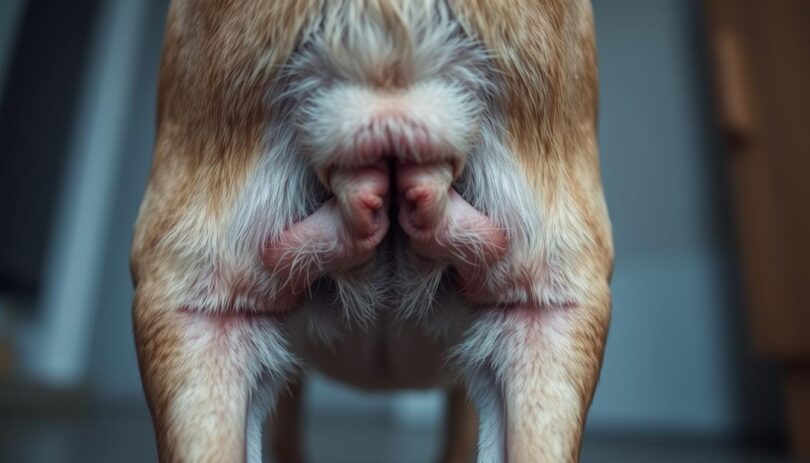Have you ever been curious as to why your dog has loose or watery stools at times? Diarrhea in dogs is not simply an ugly mess; it is an indication that something could be wrong with your pet digestive system. It is a widespread problem, but knowing what causes it and what its symptoms are is essential to every responsible pet owner.
Diarrhea is not a disease but a symptom of other underlying diseases. It may be caused by the fact that one has eaten the wrong food to more severe medical issues. As an example, the causes are often dietary indiscretion or exposure to toxins. In other instances, it may be an indication of infection or even a long-term health problem.
It is necessary to understand when the diarrhea of your dog is a small, temporary issue or an indication of something more dangerous. Although mild cases are usually self-limiting, severe or chronic diarrhea needs veterinary attention. The length of the symptoms, the age of your dog, and the general health condition have a considerable influence on the choice of the most appropriate course of action.
- Diarrhea in dogs may be caused by a number of factors such as dietary problems, infections, or toxins.
- Observe the symptoms of your dog; take your dog to a veterinarian in case of diarrhea lasting more than 48-72 hours.
- Effective treatment and a quick recovery is only possible after proper diagnosis.
Knowing the symptoms and acting at the right time, you will make your furry friend feel better and avoid more severe complications. This article will take you through the causes, symptoms, and practical measures that you can take to ensure that you control your dogs diarrhea.
Recognizing the Signs and Symptoms
Dog diarrhea may be mild or severe and can be presented in different ways, so it is essential that pet owners identify the visual and behavioral symptoms. The typical symptoms are loose, watery bowel movements that can either come on abruptly or can be chronic. Alterations in the behavior of your dog, e.g. lethargy or loss of appetite, may also indicate that something is wrong.
Identifying Common Symptoms
The stool of your dog is one of the most obvious symptoms of diarrhea. When the stool is runny, loose, or of a weird color, then there may be a problem. Also, the stool containing blood or mucus should be a reason of concern and should be addressed immediately. Additional symptoms to be on the lookout are vomiting, dehydration, lethargy, and fever.
When to Monitor vs. Seek Emergency Care
Although diarrhea in some cases can be resolved naturally, in other cases, it is necessary to seek veterinary assistance. When your dog has constant diarrhea, in particular, when it is combined with vomiting, lethargy, or dehydration, you should contact a specialist. Emergency cases are when your dog has swallowed a foreign body, or when it has symptoms of an obstruction, i.e. extreme abdominal distension or failure to defecate.
Your vet may conduct a physical examination and lab work like stool tests or blood tests in order to figure out the root cause. It is important to monitor the behavior and appetite of your dog in case of diarrhea. Recording symptoms, including how long the diarrhea has been going on, the color of the stool, and any other symptoms like vomiting or lethargy will assist your veterinarian to give a proper diagnosis and course of action.
Understanding Dog Diarrhea: Types, Causes, and Diagnostic Steps
Gastrointestinal disorders in pets are uncomfortable, more so when they are accompanied by loose bowel movements. Dogs do not have diarrhea as a disease but it is a symptom of other underlying conditions. It may be acute or chronic, and both have various consequences on the health of your pet.
Types of Diarrhea
There are four major types of diarrhea; osmotic, secretory, exudative and rapid transit. Osmotic diarrhea is associated with the movement of water into the bowel as a result of substances that cannot be absorbed by the body. Secretory diarrhea is caused by an overactive intestinal secretion. Exudative diarrhea is characterized by inflammation, which makes blood or mucus appear. Rapid transit diarrhea occurs when food passes too fast through the intestines, and does not get absorbed.
Common Causes and Prevention
The most common causes are dietary indiscretion, infections (parvovirus) and internal parasites. Episodes can be provoked by sudden alterations in diet or consumption of harmful substances. Vaccinations and parasite prevention are crucial preventive measures. Vaccinating your pet will also prevent infections that cause diarrhea.
Diagnostic Steps
Veterinarians use various tests to identify the underlying cause. Typical tests are blood tests, stool, and imaging tests like X-rays or ultrasounds. Intestinal biopsies can be required in other instances to make a correct diagnosis. Understanding the root cause is essential for effective treatment.
With knowledge of the types, causes, and steps to diagnosis, pet owners will be able to manage the health of their pet better. Complications can be avoided by early detection and appropriate care and lead to a quick recovery.
How to Manage Dog Diarrhea at Home
Is your furry friend experiencing loose stools? Although it is a widespread problem, there is a lot that can be done at home to manage it. For mild cases, home care can be very effective.
Implementing a Bland Diet and Fasting
It is frequently suggested that a 12- to 24-hour fast is necessary to allow the digestive system to rest. Following the fasting period, start with bland diet such as boiled chicken and white rice. These foods are not harsh on the stomach and can make stools firm.
At-Home Care Techniques and Hydration Tips
Keep your pet well-hydrated by offering plenty of water. You can also add a little low sodium chicken broth to make it more attractive. Observe the food intake and slowly add more food as they heal.
When symptoms fail to improve after a day or two, then you need to visit your vet. Many mild cases can be treated safely at home, with proper care.
Working with Your Veterinarian for Effective Treatment
It is important to work with a vet to make a proper diagnosis and treatment plan when the condition of your pet does not respond to home care. More serious cases can be treated with the help of veterinarians.
Understanding Diagnostic Procedures
The initial steps your vet will take will probably be a physical examination and inquiry about the symptoms of your pet. Blood work or fecal exams are some of the diagnostic tests that can help determine underlying problems like infections or parasites. In other instances, imaging tests might be required to eliminate obstructions or other severe diseases.
Medication, Fluid Therapy, and Treatment Options
Treatment depends on the root cause. A typical therapy is fluid therapy to reverse dehydration and medications may involve antibiotics in the case of infections or anti-parasitic medication. The vet can also prescribe a certain diet to facilitate recovery. In extreme cases, hospitalization is done to provide close supervision and prompt treatment.
With the help of your vet, you can make sure your pet has the best care, which will result in a quick recovery and avoidance of complications in the future.
Final Tips for Supporting Your Dog’s Rapid Recovery
When your pet has had a case of loose stools, it is important to take care of their diet and surroundings to help them recover. To avoid the further occurrence, concentrate on the possible causes like toxins or alterations in their food that may provoke the problems.
Observe the internal recovery of your pet by looking out to see whether their bowel is returning to normal. In case your pet has continued symptoms, talk to your veterinarian to discuss any required changes in medicine. Recurrence can be prevented by observing good sanitation and making gradual changes in diet.
Choose high-quality food that promotes digestive health when choosing the food of your pet. Gradually introduce their usual diet, at first combining it with tasteless food in order to help their system back to normal eating. Making sure your pet is hydrated and feeding it regularly will also be helpful in their recovery.
These tips along with preventive measures will help your pet to recover fast and live a long healthy life.
FAQ
Which are the most frequent causes of diarrhea in pets?
Some of the common causes of the condition are dietary changes, infections, parasites, food allergies, or other underlying health conditions such as inflammatory bowel disease. Consult your vet to identify the root cause.
What are the signs that I should know that my pet is in an emergency due to diarrhea?
Take your pet to the vet immediately when he/she has blood in stool, vomiting, lethargy, or he/she refuses to drink water. Such symptoms may be signs of severe problems such as internal blockages or parvovirus.
What diagnostic tests might my vet perform?
Examples of tests are stool analysis, blood tests, or imaging to examine internal problems. These assist in identifying whether it is infection, parasite, or some other health issue.
Can I treat my pet’s diarrhea at home?
Mild cases could be treated by bland diet of boiled chicken and rice. Never treat the condition yourself without first consulting your vet since you may make it worse with improper treatment.
How can I prevent diarrhea in my pet?
Make sure your pet is immunized against such diseases as parvovirus and has a regular, high-quality diet. Regular vet check-ups can also help catch issues early.
What happens when my pet has diarrhea longer than a few days?
Prolonged diarrhea can lead to dehydration and other complications. Call your vet as soon as possible to seek professional help and treatment.










Leave a Comment